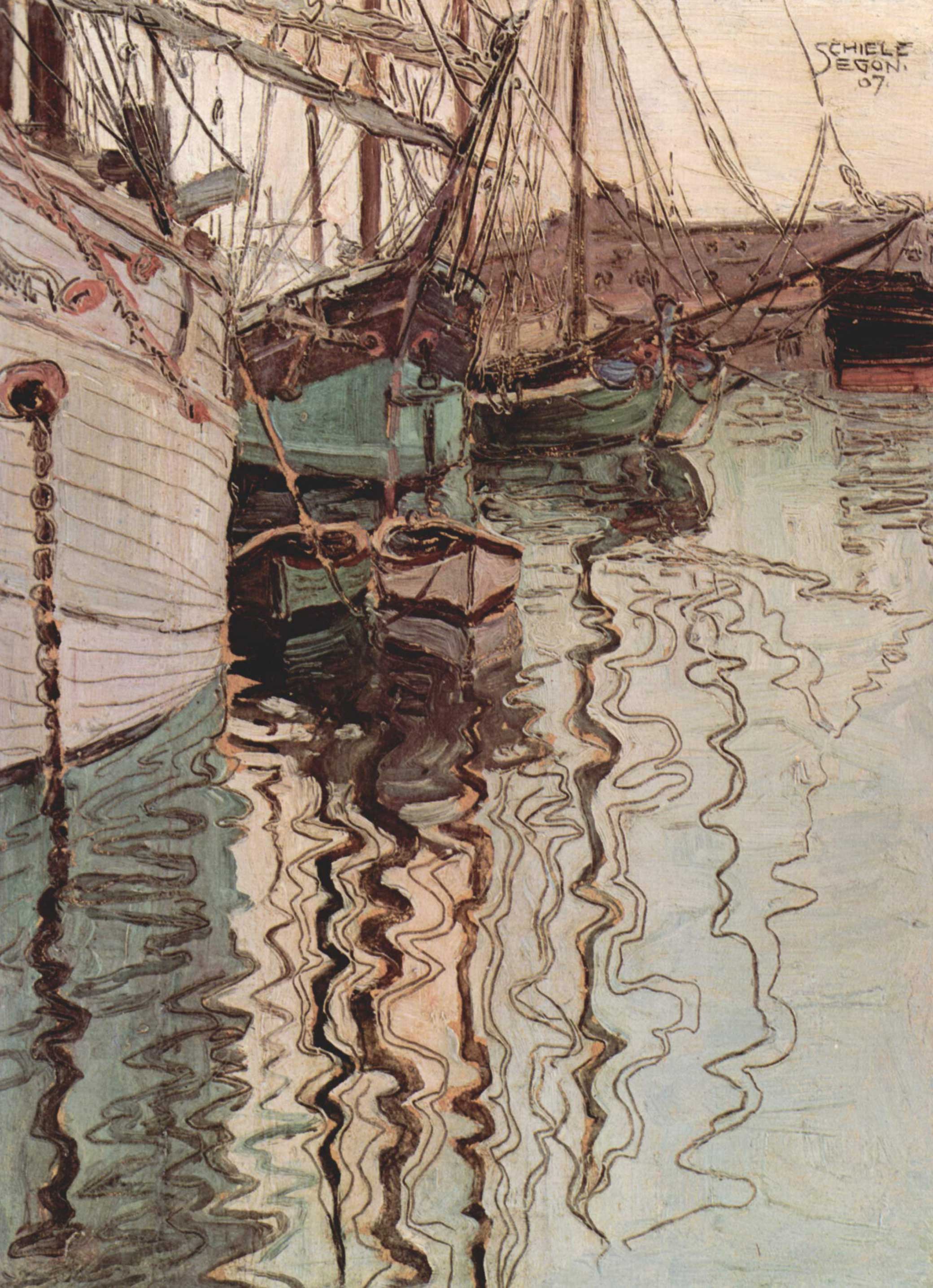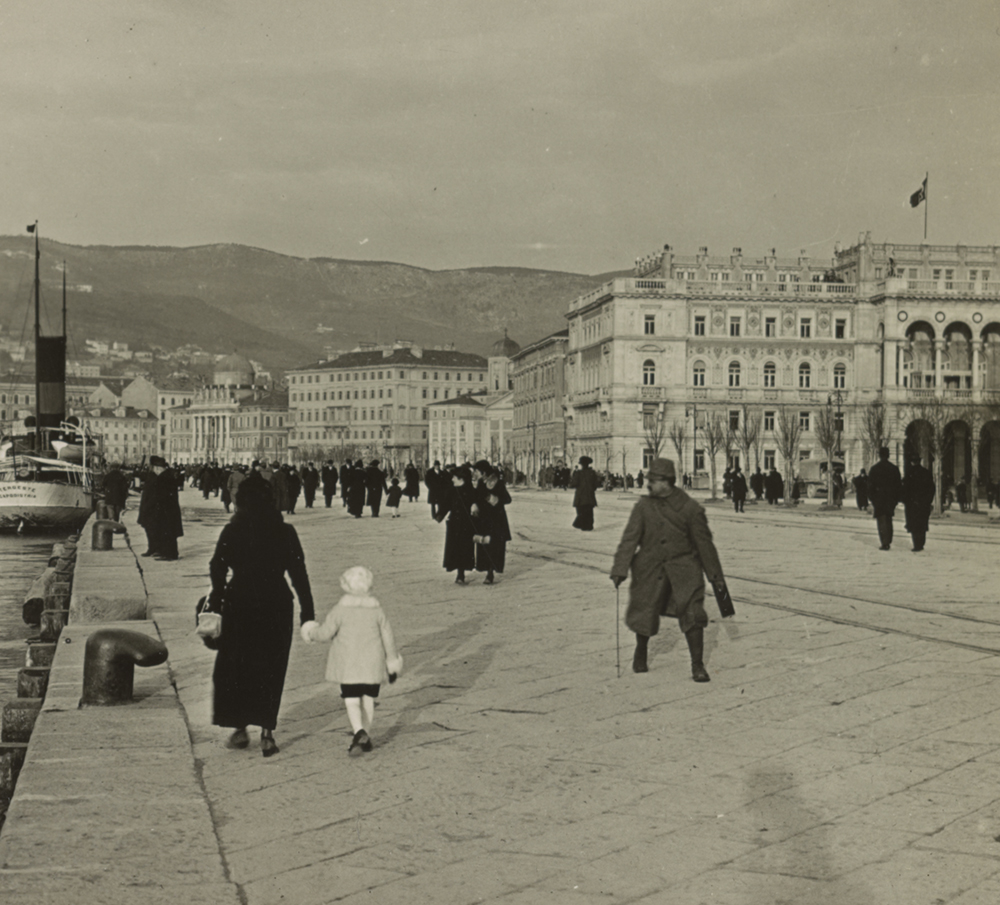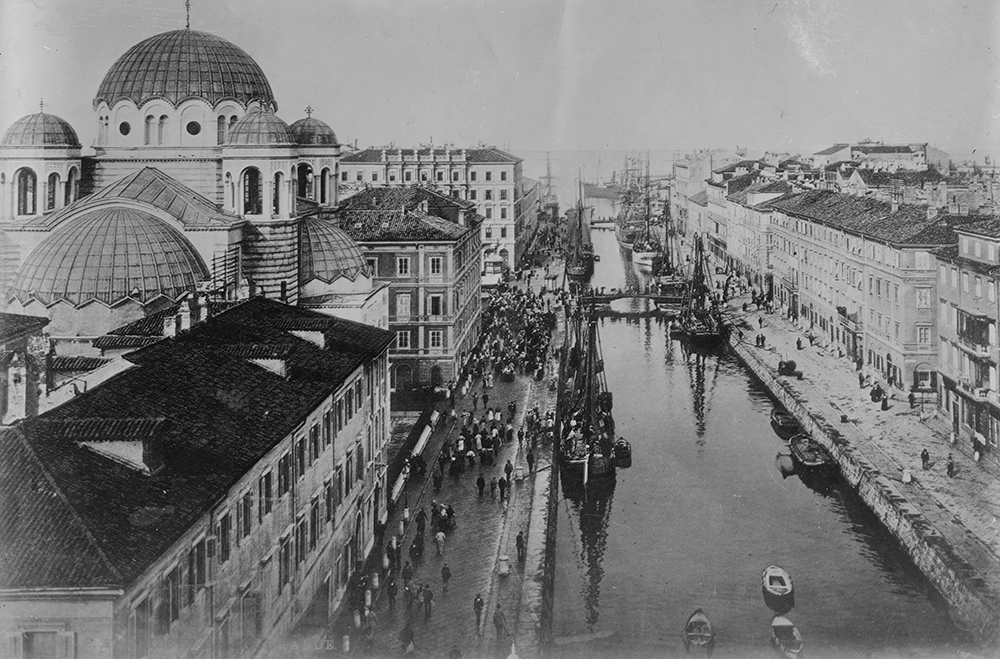
The Port of Trieste, by Egon Schiele, 1907. Wikimedia Commons.
For Chateaubriand, the port city Trieste was the shore where the last breath of Italy expired and “barbarism” began. Stendhal mainly remembered “the abominable bora,” the tumultuous winds that rush, typically in winter, from the Slovenian Karst over the Gulf of Trieste. Of all these (often French) chroniclers who made famous their ambivalence about the city, perhaps only Valery Larbaud glimpsed something of Trieste’s liminal enchantment. In his 1913 novel The Diary of A.O. Barnabooth, speaking through the alter ego of a wealthy South American on a grand tour, Larbaud immediately remarked upon the “Italianness” of the city. This Italianness was notable given the frequently shifting borders that cut across the city’s long history; it had been under the voluntary protection of the Austrian Habsburgs since 1382—when it joined the Holy Roman Empire of the German Nation—and was later formally annexed to the Austrian Empire at the Congress of Vienna. “With pleasure I find myself in Trieste, capital of the Adriatic, as Italian as Venice, but more accessible to us, with something coarse, something new,” Barnabooth observes. His comparison was provocative. Though the Triestine dialect is a Venetian one, distinguished by its lexical admixtures of German, Slovenian, Serbo-Croatian, and Greek, it was from the Republic of Venice that Trieste—several times ruinously occupied by its maritime neighbor—had long fought for its freedom. Barnabooth comments on the everywhereness of the place, “the commingling of the Italian names of the streets, the Slavic names of the signs, the German inscriptions on the front of monuments, and the Austrian uniform, which is of a piercing blue in this light, sums up the political situation.”
A formidable polyglot with a broad knowledge of European literature, Larbaud described Trieste’s consummate Europeanness just when the city’s peace was about to unravel, and with it the liberal democratic hopes of the long nineteenth century. If modernism found such fertile ground in this deepwater port with little more than thirty-two square miles to its name, it was perhaps because Trieste seemed to encompass the whole continent, bringing the Mediterranean South, the Germanic North, and the Slavic East together in the increasingly fragile promise of a borderless future perfectly suited to the utopian internationalism of the modernists who moved there. It was precisely this early vision of a transnational Europe that World War I would shatter, leaving many who had known Trieste’s fertile coexistence nostalgic for the social and cultural complexities of an empire for which, politically, they had scant appetite.
By the time Larbaud’s Diary was published in 1913, Trieste was already being torn apart in the struggle for power between the German speakers faithful to the Habsburg crown and the Italian irredentists who believed the peninsula all their own. This conflict left Trieste’s significant Slovenian-speaking community (which outnumbered the population of Ljubljana) positioned uncomfortably between the protection of Vienna and the Pan-Slavic republicanism that joined—particularly in its Austro-Slavic form—Polish, Slovakian, Czech, Slovenian, Croatian, and Serbian subjects of the Austro-Hungarian Empire. Though the prosperous port had taken no part in the antimonarchist revolutions that swept Europe in 1848, prompting Emperor Franz Joseph to name it urbs fidelissima (most loyal city), some of Trieste’s residents embraced Italian separatism in the early twentieth century. That led Trieste’s imperial steward, Prince Konrad of Hohenlohe-Schillingsfürst, to remove all Italian municipal clerks from their posts on August 21, 1913. The Austrian modernist Robert Musil arrived in Italy the same month. He devoted a central chapter of his unfinished 1930 novel The Man Without Qualities to “the Triestine story,” later identifying it with the unraveling of central Europe and the coming of World War I (in which Musil would serve). In a fictionalized allusion to the August 1913 crisis, he stages a dialogue between the novel’s protagonist, Ulrich, and a certain Count Leinsdorf, who complains, “I was there once on His Majesty’s [Franz Joseph’s] birthday: not a single flag in all Trieste…But if you should have any business in some municipal office in Trieste on the king of Italy’s birthday, you wouldn’t find a clerk anywhere without a flower in his buttonhole!”
Just how brightly, how oddly, the imperial bureaucracy glittered in the Triestine imagination becomes clear in a wistful essay by Roberto Bazlen, an erudite and elusive figure born to a German father and an Italian mother in the city in 1902. Retrospectively evoking the political ambiguities of what he called Trieste’s “peaceful, well-fed, equitable” prewar life, Bazlen was moved to recall its almost magical administrators:
So, this city that speaks a Venetian dialect, and this countryside that speaks a Slavic dialect, are entrusted to an Austrian bureaucracy that’s irreproachable, but that speaks German. A world of high bureaucracy, composed in large part of aristocrats with little blond daughters with governesses, with Bösendorfer pianos, with old Vienna porcelain, with Biedermeier furniture, who permit everything, who (and with more style) are more liberal than the irredentists.
And with more style—here we know we are in the realm of literature, a literature of nostalgia for the machinery of liberal monarchy that made possible, for a time, the improbable élan of Trieste.

Musil lived to see this world destroyed not once but twice, fleeing in 1938 to Zurich, where he took up residence with a quasi-Triestine community of exiles from Austria, Italy, and the Balkans in the poignantly named Pension Fortuna at Mühlebachstrasse 55. His near neighbor, living in the Pension Delphin at Mühlebachstrasse 69, was James Joyce; though the two never spoke, both would evoke a vanished Trieste in their work. Before Trieste’s last flourishing of cosmopolitan modernism could be eulogized, however, the community that made it possible had to be built.
Joyce had first gone to Zurich in October 1904 on what turned out to be a spurious offer to teach English at the Berlitz School. An actual job awaited him at the Berlitz School in Trieste, where he moved that same month. Though he was very poor—“And Trieste, ah Trieste I ate my liver!” he wrote in Finnegans Wake—Joyce quickly grew attached to his latest adoptive city, referring only partly ironically in a letter of 1909 to “La nostra bella Trieste!” A central figure in Joyce’s exclamatory relationship with Trieste was Italo Svevo—born Ettore Schmitz to a German father and an Italian mother, like Bazlen—who came to Joyce for English lessons in 1907 and later became known as a leading Italian modernist. True to the spirit of the city, Joyce sought tutors in German and Greek, all the while perfecting his Italian and acquiring the local dialect. It was in Trieste that Joyce finished Dubliners, rewrote Stephen Hero as A Portrait of the Artist as a Young Man, and drafted preparatory notes and the first chapters of Ulysses. From 1907 to 1912, Joyce also reported in Italian on Irish culture and politics in a series of eight articles for Il Piccolo, the main Triestine daily.
In a letter written to his brother Stanislaus in April 1907, Joyce even went so far as to threaten to “unlearn” English and write exclusively in French or Italian. Though he did not unlearn English, he and Nora Barnacle raised their children, Giorgio and Lucia, speaking the Triestine dialect alongside the formal Tuscan cultivated in his journalism (a legacy, in part, of Joyce’s long study of Italian, which he started learning at the age of twelve at Belvedere College in Dublin). This peculiar domestic linguistic arrangement gave rise to much puzzlement, not least among the Austrian bureaucrats tasked with the completion of the 1910 census. Joyce had listed Italian as the common language for Giorgio, Lucia, and their ethnically Slovenian family maid Maria Kirn. Refusing the possibility of Italian-speaking children of Anglophone parents, census officials struck out Joyce’s responses, writing “Fr.” (for Fremdsprache, foreign language) over his family’s entries and stamping “Slowenisch” (Slovenian) over the Italian indicated for Maria Kirn. Though Joyce was hired to teach Svevo English, the two ended up mostly speaking Italian. In a 1927 lecture in Milan, Svevo said of Joyce, “We Triestines have a right to regard him with deep affection as if he belonged in a certain sense to us.”
When World War I brought Italy to war against the Austro-Hungarian dual monarchy, Joyce sought refuge in Zurich, but it was only in 1920 that he left Trieste for good, moving to Paris at the instigation of Ezra Pound. It was likewise Pound who introduced Joyce to Valery Larbaud, whose character Barnabooth had been so taken with Trieste. Larbaud was among the first to advocate for Ulysses, urging it on friends and arguing for its merits in a heavily attended public lecture that Larbaud later turned into an essay for the La Nouvelle Revue Française. It was to Larbaud that Joyce turned to assist in the promotion of Svevo’s Zeno’s Conscience, published in Italian in 1923 to little notice. Written in the Great War’s aftermath, when Trieste was reassigned to Italy, the novel is framed as the intimate journal of a Triestine businessman undergoing psychoanalysis. Unlike Joyce—whose German Svevo privately remarked was not good enough—Svevo could read Freud in the original and sought the judgment and friendship of Trieste’s most prominent psychoanalyst, Edoardo Weiss, who had undergone analysis with a member of the Vienna Psychoanalytic Society.
Svevo’s book represented a bold experiment in the narration of memory and mental life. It initially struggled to win a readership, in part because it was written in an Italian that many readers considered (and still consider) harsh, plain, almost foreign. Defending his fellow half-German Triestine against the critical dominance (in “Italy,” i.e., outside Trieste) of irredentist poet Gabriele D’Annunzio’s highly mannered Italian (a rhetorical instrument of his theatrically reactionary nationalism), Bazlen wrote in his “Preface to Svevo”:
Nothing will better reveal to us the gap between Svevo’s work and the work of his Italian contemporaries than the different premises from which the formal informality of Svevo arises…[and] the excessive, and anti-natural, formal perfection of Italy, which will also make clear to us why this figure could not become “enmeshed” in the prewar literary world.
While Larbaud, prodded by Joyce, was largely responsible for the eventual European dissemination of Zeno’s Conscience, Bazlen’s intervention proved decisive in Italy. Bazlen shrewdly sent the novel to the well-known Genoa-born poet Eugenio Montale (who would win the Nobel Prize in 1975). Montale then penned two laudatory articles on Svevo for the Milanese reviews L’Esame (in 1925) and Il Quindicinale (in 1926), effectively securing him an Italian audience. By 1930 Musil and his wife were reading Zeno’s Conscience, noting with pleasure Svevo’s retrospective descriptions of World War I battles Musil had fought in. Svevo was quick to pass on the help he received to yet another Trieste-born writer, the poet Umberto Saba, whose work Svevo introduced to Larbaud and Montale. Though a sparkling exponent of the Italian modernist lyric, Saba regarded the Kingdom of Italy as a somewhat foreign entity to which Trieste might be rejoined in poetry. “I had a beautiful city between the rugged mountains / and the luminous sea,” Saba wrote. “Forever I will marry her to Italy in song.”

One of Triestine modernism’s many peculiarities lies in the contrast between its considerable heterogeneity and the narrowly clannish, almost incestuous ties among its canonical figures. Women were given little place in this boys’ game of book promotion, but the writer, editor, and artist Anita Pittoni fought hard for one, writing stories; publishing Svevo and Saba at Lo Zibaldone, the publishing house she founded; and maintaining a rich correspondence with Bazlen, whom she counted among those who “feel Trieste in the secret ripplings of its sentiments and aspirations.”
The Slovenian literature of Trieste would have to wait longer to be discovered by non-Slovenians, often through French translations. The poetry of Srečko Kosovel, a haunting and enigmatic poet of the Karst who died at twenty-two in 1926, was ignored by his Italian contemporaries. At the end of World War I, Kosovel warned of the threat posed by the Italian fascists who sought to ban German and Slovenian from Trieste’s public life. In July 1920 this menace degenerated into violence, with Blackshirts burning down Trieste’s magnificent Slovenian community center, Narodni Dom, a six-story palace of culture whose destruction Mussolini hailed as a “masterwork” of what he grotesquely termed “Triestine fascism,” a phrase of great darkness.
Mussolini would not have the last word. The infamy of the Blackshirts was witnessed by the most celebrated Slovenian novelist of Trieste, Boris Pahor, who went on to survive Dachau and Bergen-Belsen, passing in his “dear native city” at the age of 108 in May 2022. In Kres v Pristanu (Bonfire in the Port), Pahor remembered the terror of the burning of the Narodni Dom: “All of Trieste was staring at the tall white house where flames blazed at every window. Flames like sharp tongues, like red flags.” In July 2020 Pahor was invited by the presidents of Italy and Slovenia to open Trieste’s new Narodni Dom, rebuilt a hundred years later to atone for the deep wound inflicted on the Slovenian culture of the city. “Trieste has never been only Italian,” Pahor told an interviewer, in Italian. “It was also Italian.”